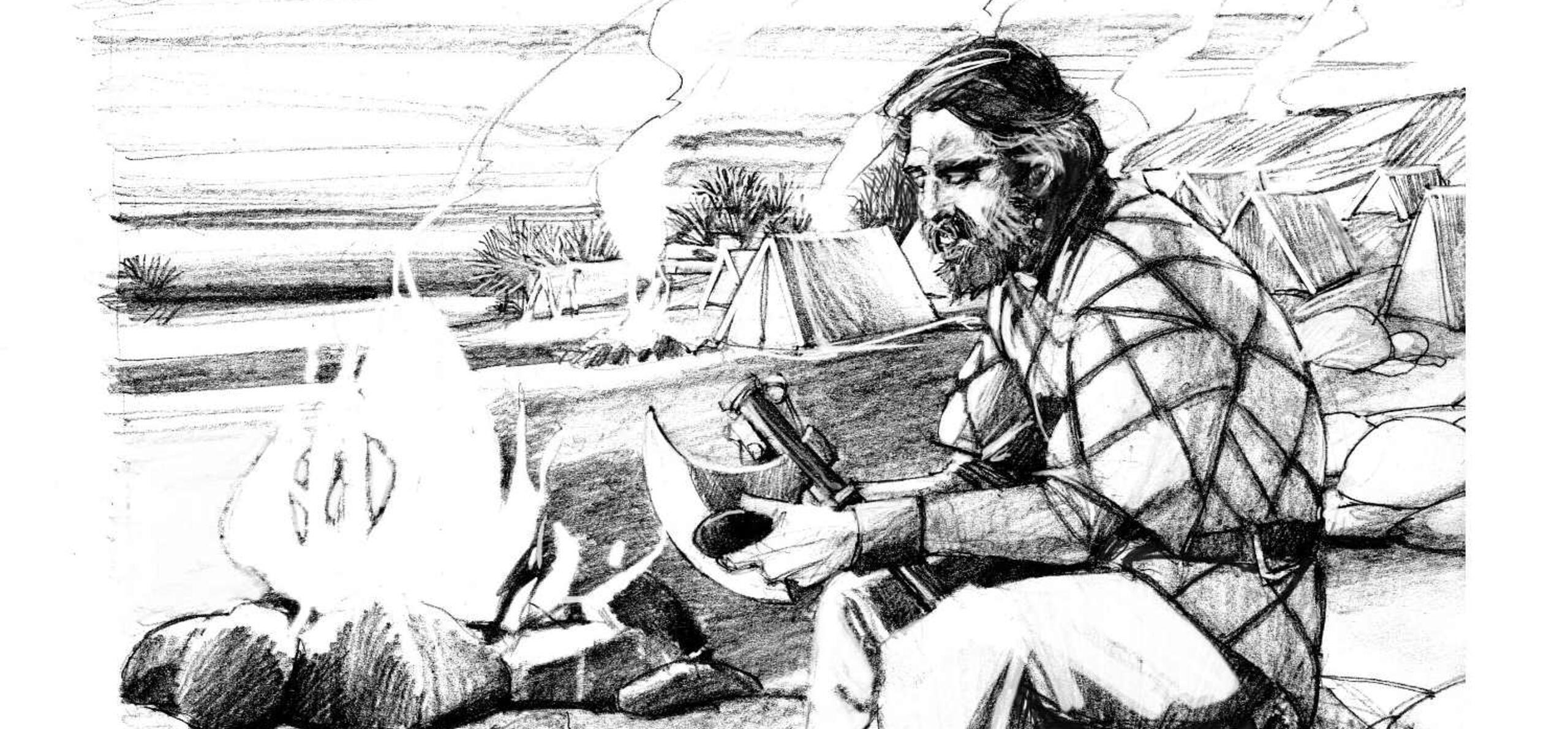Did you know that the reason for Reading’s first mention in the history books was because of the Vikings?
The Anglo-Saxon Chronicle (an annual account of national events, originally compiled in around 890 and then maintained into the 1100s) records that Danish Vikings wintered at Reading and resisted attacks by King Ethelred of Wessex and his brother Alfred (later King Alfred the Great).
Find out more about this important chapter in Reading's early history and the role the Vikings played.
Who were the Vikings?
The Vikings were Scandinavian people in the period between 750 and 1100 AD. The term is often used problematically. In Old English and Norse, the word Viking meant ‘raider’ or ‘pirate’. It was their raiding activity that was the focus of the Anglo-Saxon chroniclers, and the term is best thought of as an activity: ‘to go a-Viking’. Other terms such as ‘Danes’ and ‘Northmen’ were also used (though imprecisely) to describe them.
The earliest recorded Viking raid in England was on the south coast in 789, followed by a North Sea raid including the island of Lindisfarne in 793 (the site of a monastery built significantly earlier than Reading Abbey). These early attacks were fairly small scale and were limited to the sailing season from spring to autumn.
By the mid-800s, the Viking fleets were increasing in size from a handful of ships to hundreds, carrying thousands of men, and now often faced repelling armies of equal size. The Viking force was now described as the micel here, often translated as ‘great army’, though here was a term used for large groups of violent robbers.
Why did the Vikings have winter camps?
The micel here campaigned across the main Saxon kingdoms of Northumbria, Mercia, East Anglia and Wessex. Their shallow-bottomed ships could penetrate far inland along the major navigable rivers like the Thames, Severn, Ouse and Trent. They adopted a new strategy of overwintering in the hostile territory at strategically located monasteries or royal estate centres, where winter supplies had already been gathered. In the year 870, Reading became one of these Viking winter bases.
From these camps, the Viking warriors could re-supply for further raids or agree truces to allow them to stay in peace over the winter months. Gradually the Vikings controlled Northumbria and East Anglia, and much of Mercia. Scandinavian settlements were established across northern and eastern England. They almost took Wessex, but King Alfred (reigned 871 to 899) successfully secured his kingdom and went on to integrate Wessex and Mercia into what was later to become the kingdom of England.
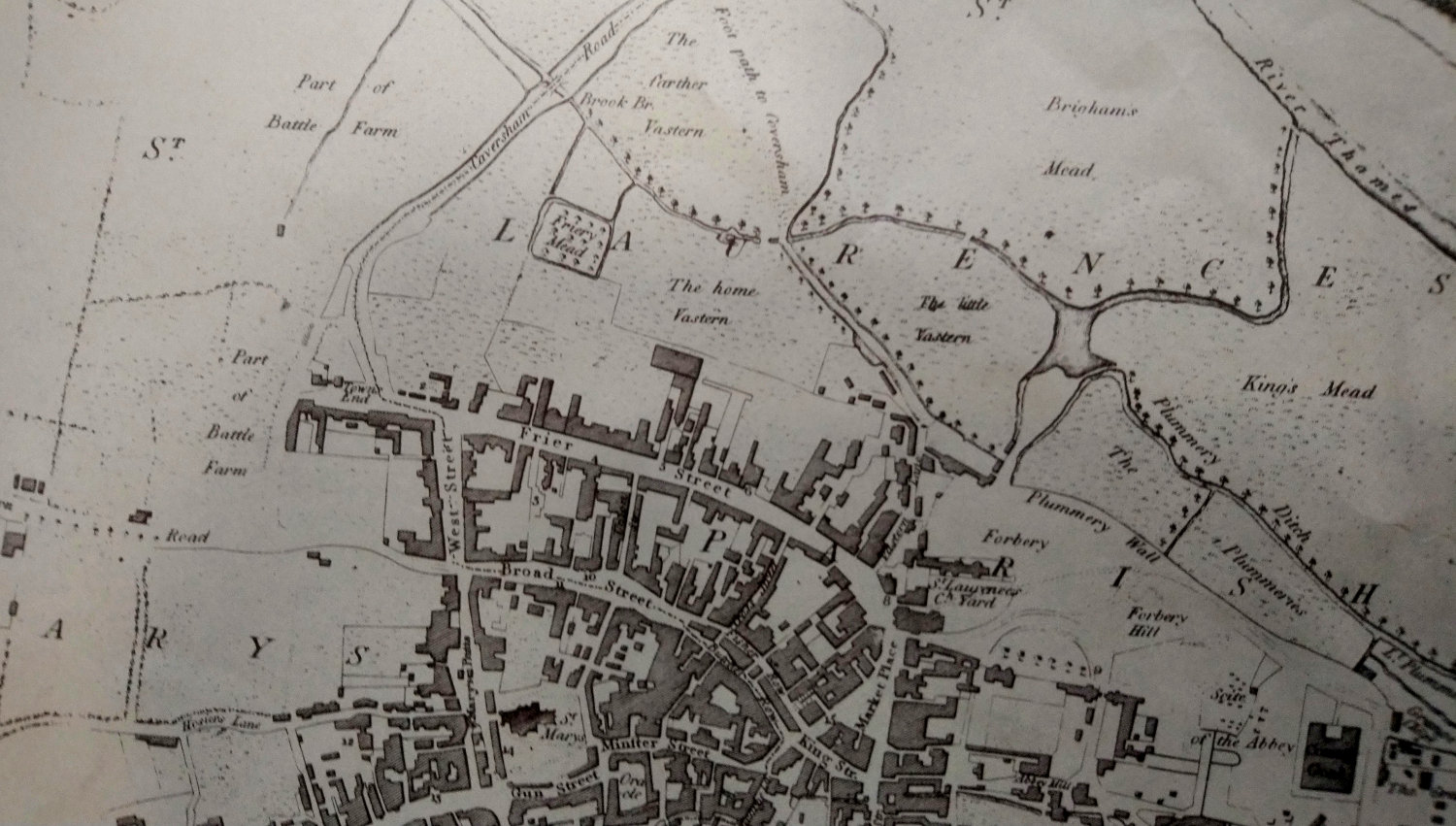
Map of Reading, from Coates' History of Reading 1802 showing Vastern meadows, and the River Thames (top right)
Where was the Viking camp at Reading?
The Life of King Alfred (written by Bishop Asser) tells us that in 870, the Vikings left East Anglia and entered Wessex, where they came to the royal ‘vill’ called Reading, on the south bank of the Thames in the district of Berkshire.
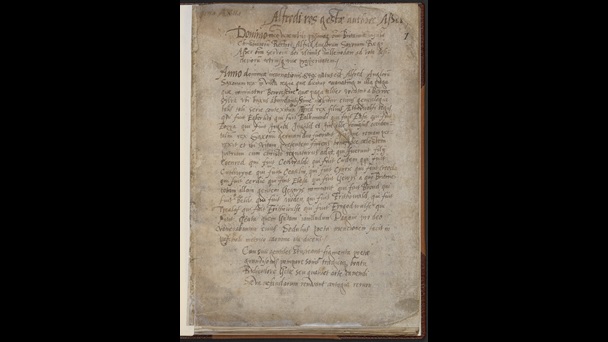
Asser's Life of King Alfred (BL Cotton MS Otho A XII/1)
Here they built a rampart between the rivers Thames and Kennet on the right hand side of the royal vill (a vill was the administrative centre of a royal estate or territory). The vill at Reading later developed into a small town and by 900 it had an important market and a nunnery. This was probably on the site of today’s Reading Minster (St Mary’s Church). In 1839, a late 9th-century coin hoard of silver pennies was found in a stone coffin in the churchyard of the Minster. The coins were probably buried in 875AD, as the hoard consisted of coins of Burgred, King of Mercia from 852 to 874AD, and Ceolnoth, Archbishop of Canterbury, 833-870AD.
This evidence indicates that the Viking camp, with its fortified rampart, was located to the east of today’s town centre. It has been suggested that it was situated near the site of the later Reading Abbey, on the wedge-shaped gravel ridge between the two rivers.
The local place-name ‘Vastern’ is another piece of evidence. It is an Old English word for ‘stronghold’ and is an indication of the approximate location of the Viking fortified camp at Reading. In 1233, the Abbot of Reading gave the Vastern land to the Greyfriars to set up their first friary (this moved to its present location in 1311). Coates's 1802 map of Reading shows that it applied to an area of low-lying meadows immediately north of Friar Street and the Forbury running up to south bank of the River Thames. The Vastern was divided by water-filled ditches into the Home, Little and Further Vasterns. Blagrave Street was originally called Vastern Lane as it led to the Vasterns. Today, this name is retained in Vastern Road, just north of Reading station.
In 1831, a Viking sword was found in the Vastern, with the skeleton of a man and a horse, while workmen were digging a railway ballast pit. The sword handle has copper-alloy guards at each end of the handgrip, decorated in a style characteristic of 9th-century Scandinavian workmanship called ‘Gripping Bear’. The Anglo-Saxon Chronicle records that Wessex Ealdorman Aethelfwulf (an ealdorman is a nobleman) fought against the Vikings at nearby Englefield in 871, killing one of the Viking leaders named Sidroc. It is tempting to speculate that this is Sirdoc and his sword, buried at the Reading camp. Other than this, no further Viking finds are recorded, but it is likely that much of the site was subsequently buried under the Great Western Railway embankments.
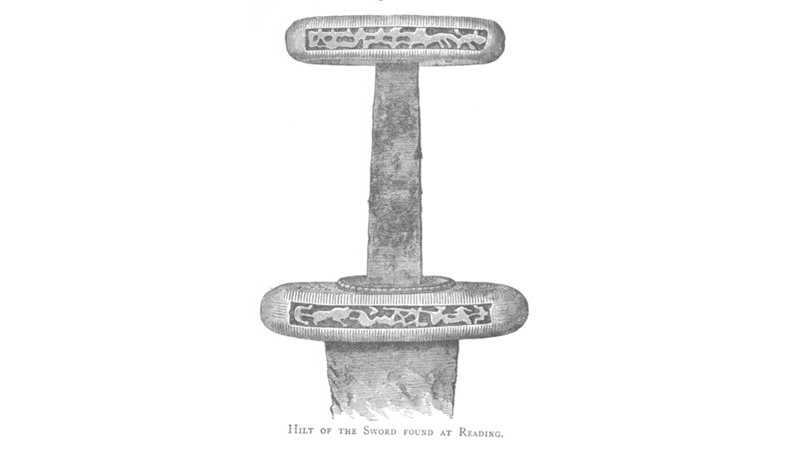
The Viking sword found at Reading in 1831.
What were Viking camps like?
We have no physical remains of the Viking camp at Reading but archaeological evidence from two winter camps overlooking the floodplain of the River Trent at Torksey (AD 872-873) and Repton (AD 873-874) give us clues to the form of Reading’s winter camp.
Torksey (Lincolnshire) is a natural oval of high ground overlooking the Trent’s floodplain. A near-vertical cliff down to the river forms one edge, whilst the other surrounding land was prone to flooding. In the Viking period it was probably a natural island, especially in winter. A recent research project on the archaeological find concentrations at the site suggests the camp occupied an area of around 26 hectares. There is no evidence for defensive ditches.
The camp at Repton (Derbyshire) was first investigated in 1975 revealing a fortified D-shaped enclosure covering only 1.5 hectares. Now, a team from the University of Bristol has found evidence of activity, including metalworking and ship repair, in the area outside this enclosure suggesting a far larger camp like that at Torskey. The overwintering Viking army lived under canvas, rather than constructing timber structures. The size of the Viking forces has been much debated but work at these sites suggests that lower estimates of 300-500 are too conservative.
This suggests that the Reading camp was similarly located on slightly higher ground on the edge of the Thames floodplain, with marshy land providing natural defences on three sides. Like Repton, it probably had an inner defensive enclosure or ditch, possibly securing the rising ground towards the vill on its southern side. It may be that the Forbury, which is Old English for the ‘area in front of the burgh or town’, relates to this southern side. It has been suggested that the Plummery Ditch, a water-filled dyke between the two rivers that ran along the north side of the Forbury, was part of the camp defences.
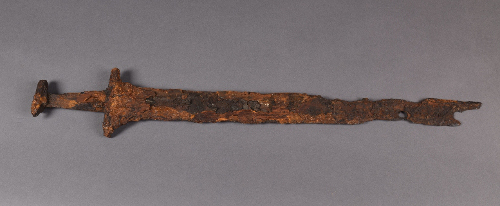
10th/11th century Viking sword dredged from the River Kennet, Kennetmouth (museum no. REDMG : 1961.90.1). On display in the Story of Reading Gallery.
What happened after 871?
Reading was mentioned again in the Anglo-Saxon Chronicle in 1006, when the Vikings wintered there again. By the 1040s, Reading was still the centre of a royal estate but was also established as one of the area’s leading towns. It had a mint (where coins are made) and a weekly market. In the whole of Berkshire, only Wallingford shared this important privilege at the time. After the Norman Conquest in 1066, Reading's position as Berkshire’s leading town was secured by the foundation of Reading Abbey by William the Conqueror's son, King Henry I in 1121.
References
Max Adams (2017) Alfred’s Britain – war and peace in the Viking age, Head of Zeus
Grenville G. Astill (1978) Historic towns in Berkshire: an archaeological appraisal, Berkshire Archaeological Committee
Margaret Gelling (1982) The Place-Names of Berkshire – Part 1, English Place Name Society (page 174 on origin of Vastern)
David A. Hinton (2008) The Alfred Jewel, Ashmolean Museum
John Peddie (1999) Alfred : Warrior King, Sutton
Gareth Williams and John Naylor (2016) King Alfred’s Coins – The Watlington Hoard, Ashmolean Museum
Online
Asser’s life of Alfred (translated from the text of Stevenson’s edition by Albert S Cook, 1906). Digitised in 2007, accessed from https://archive.org/stream/asserslifeofking00asseiala/asserslifeofking0…
Archaeology, 2017, New Research on Viking Army Camp at Repton www.archaeology.org/news/6118-171122-england-viking-camp
Current Archaeology, 2013, Viking Torksey: Inside the Great Army’s winter camp www.archaeology.co.uk/articles/viking-torksey-inside-the-great-armys-wi…
Dawn Hadley and Julian Richards, 2018, In Search of the Viking Great Army : Beyond the Winter Camps. Medieval Settlement Research. pp. 1-17 at https://eprints.whiterose.ac.uk/138571/8/001_017_Hadley_Richards_corrected.pdf
Museum Galleries
You can see Viking finds from the Thames and Kennet in the Story of Reading Gallery, and there are Norman weapons in the Bayeux Tapestry Gallery.
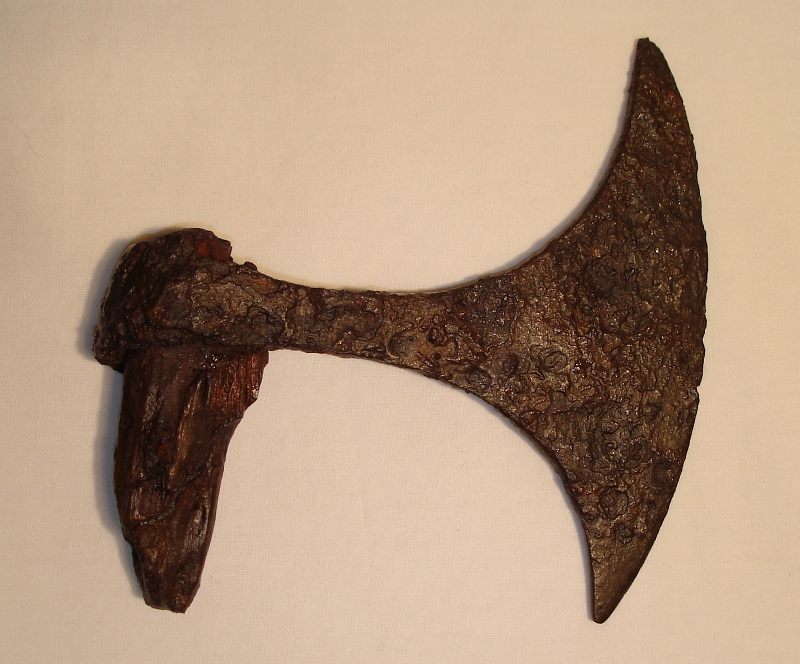
Viking iron axehead with remains of its wooden shaft, from the Thames at Sonning, found in 1895. It is displayed in the Story of Reading Gallery (museum no. 1945.$353.1)
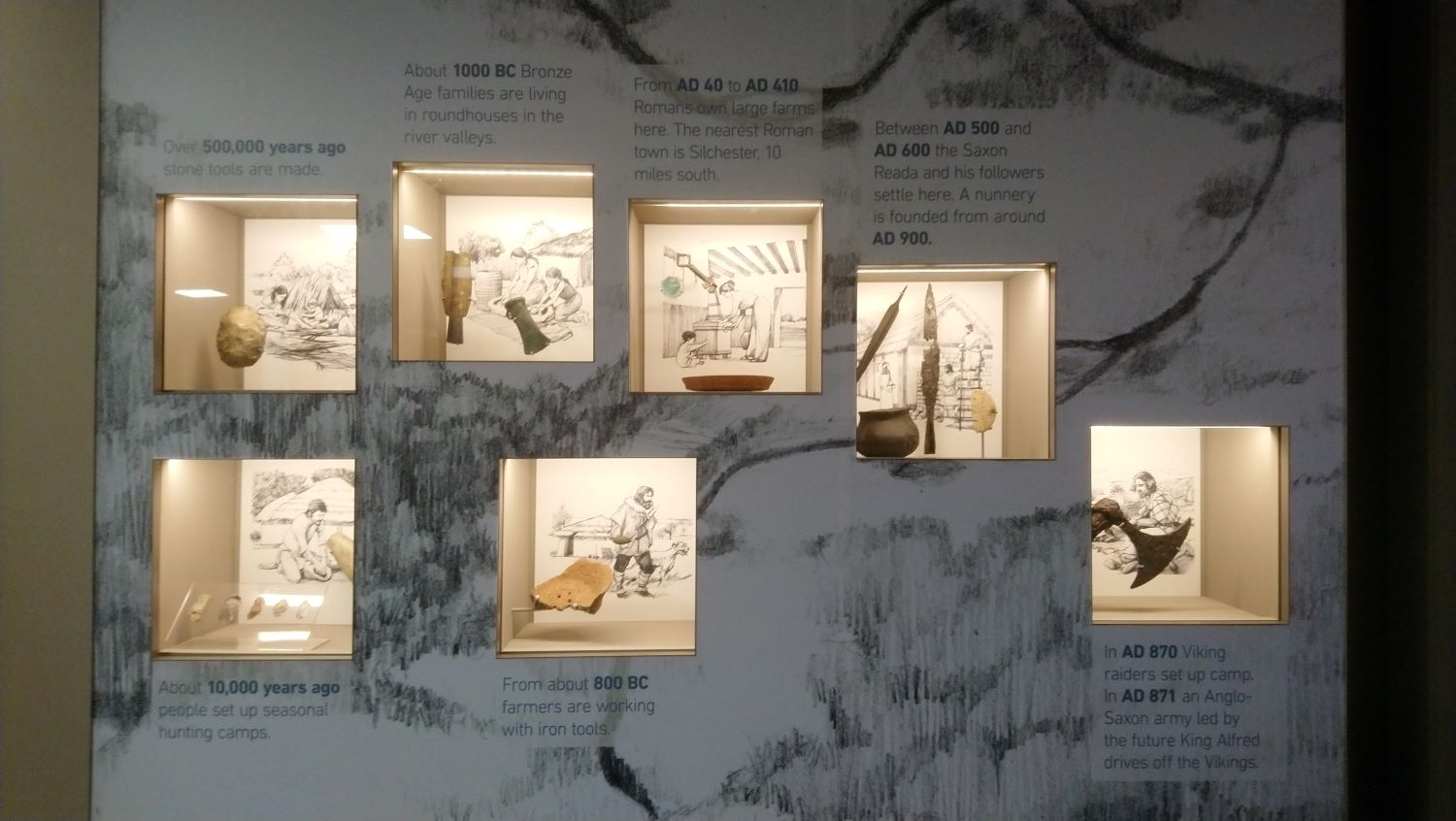
Archaeological finds on display in the Story of Reading Gallery
